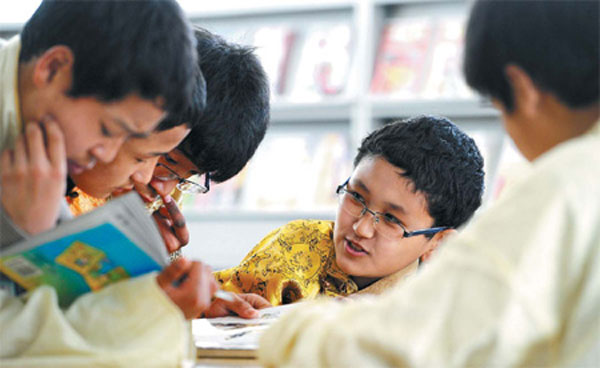Learning to close the gap
Updated: 2011-05-06 11:06
By Hu Yongqi (China Daily European Weekly)
 |
|
Tibetan middle school students study at a library in Hefei, capital of Anhui province, in this photo taken on April 23. Liu Junxi / Xinhua |
Thousands of students have benefited from Tibet middle school program set up outside the autonomous region
Sonam Jorden has come a long way from the days when he walked 10 kilometers along dirt roads to his remote primary school in the Tibet autonomous region. At 29, he is a maintenance engineer at the largest geothermal power operation in China. He is now back home in Tibet, but his route from birthplace to first job took him to coastal China for 10 years of schooling, starting in a Tibet middle school. The middle school program was launched in 1985 to overcome a shortage of facilities in Tibet. Since then, about 34,900 children have left their homes on the plateau or in mountains and valleys to study in 21 regions outside Tibet, and 18,000 have returned to work in Tibet.
"Tibet middle schools in other provinces and municipalities have become an important educational platform for Tibetan children that brings them a precious opportunity for better education and career prospects," says Song Heping, director of Tibet's education department.
Sonam Jorden says his studies "fundamentally changed" his life and the fate of his family. That's the goal of the program: To change the fate of young Tibetans and contribute to the region's social and economic development.
Education fundamental
In August 1984, an inspection team led by Vice-Premier Tian Jiyun surveyed education in Tibet and found the region with few qualified teachers. Before 1951, monasteries were the only place to learn to read and write, leaving most Tibetans illiterate.
Four months after the education survey, the Ministry of Education and the State Planning Commission issued a notice establishing three middle schools in Beijing, Tianjin and Lanzhou, for Tibetan students. Each was to recruit 700 students. The notice also stipulated that 16 Tibet classes would be set up in places such as Shanghai and Tianjin municipalities, Zhejiang and Anhui provinces.
Since 1989, the program has expanded to include high school classes at three schools, and 14,900 young people have qualified to study at that level. More than 11,000 have graduated from 90 key universities across China.
The current enrollment at 28 Tibet middle schools in 21 provinces outside the autonomous region is 21,800 students, according to the education department of Tibet. Their food and accommodations are paid for by the central government. The program also has expanded to include training for technical personnel and teachers for Tibet.
"Education and educated people are fundamental to local development, especially for remote Tibet," says Tenzin, director of the Social and Economic Institute at China Tibetology Research Center in Beijing.
For two decades, 29 provinces, municipalities and autonomous regions have sent teachers to Tibet to work with teachers and children there. But that approach "is relatively a short-term effort, lacking continuity", says Zhang Mei, vice-president of Beijing Tibet Middle School. "Therefore, we should take advantage of education resources in eastern and central regions to provide Tibetan students with sustainable access to higher education."
Students trained in the Tibet middle school project have grown to form a majority in all trades and professions in Tibet, Tanzin says. Many have taken leadership positions in companies and government, contributing more to the development of their native region.
"Our teachers could meet our students almost in every corner of Tibet," says Zhang, who has been at the school since it opened in 1987.
Beijing Tibet Middle School is the largest and best-known Tibet middle school in the country. By the end of 2010, it had educated 1,135 middle school students and more than 3,100 high school students. More than 2,000 of its students have returned to Tibet, working in such fields as telecommunications, banking, education, newspapers and the energy industry.
E-paper

Tapping into the future
Foreign companies are investing in China's water industry as many predict a growing profit margin.
Headhunters ride on growth
Commercial property rides wave
Learning from the past
Specials

Cuisine central
London's Chinatown is helping diners appreciate full palate of Chinese food

Tying the knot
Danish couple's high-end macrame export business takes off in the mountains of Yunnan.

Truly a super woman
Li Yuchun first came to prominence in 2005 as the Super Girl winner, and since then has become an international star.
